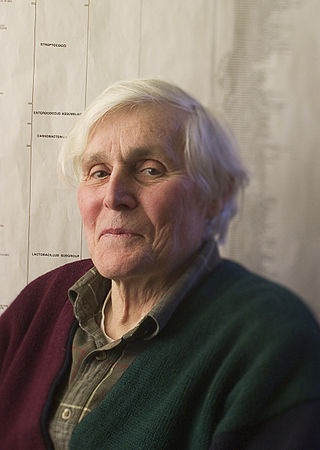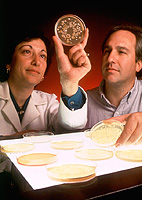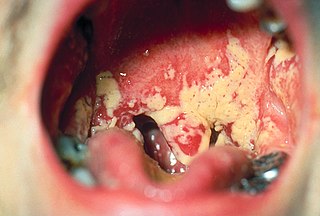
A microorganism, or microbe, is an organism of microscopic size, which may exist in its single-celled form or as a colony of cells.

Carl Richard Woese was an American microbiologist and biophysicist. Woese is famous for defining the Archaea in 1977 through a pioneering phylogenetic taxonomy of 16S ribosomal RNA, a technique that has revolutionized microbiology. He also originated the RNA world hypothesis in 1967, although not by that name. Woese held the Stanley O. Ikenberry Chair and was professor of microbiology at the University of Illinois at Urbana–Champaign.

Bacteriology is the branch and specialty of biology that studies the morphology, ecology, genetics and biochemistry of bacteria as well as many other aspects related to them. This subdivision of microbiology involves the identification, classification, and characterization of bacterial species. Because of the similarity of thinking and working with microorganisms other than bacteria, such as protozoa, fungi, and viruses, there has been a tendency for the field of bacteriology to extend as microbiology. The terms were formerly often used interchangeably. However, bacteriology can be classified as a distinct science.

A microbiologist is a scientist who studies microscopic life forms and processes. This includes study of the growth, interactions and characteristics of microscopic organisms such as bacteria, algae, fungi, and some types of parasites and their vectors. Most microbiologists work in offices and/or research facilities, both in private biotechnology companies and in academia. Most microbiologists specialize in a given topic within microbiology such as bacteriology, parasitology, virology, or immunology.

A growth medium or culture medium is a solid, liquid, or semi-solid designed to support the growth of a population of microorganisms or cells via the process of cell proliferation or small plants like the moss Physcomitrella patens. Different types of media are used for growing different types of cells.

Stanley "Stan" Falkow was an American microbiologist and a professor of microbiology at Georgetown University, University of Washington, and Stanford University School of Medicine. Falkow is known as the father of the field of molecular microbial pathogenesis. He formulated molecular Koch's postulates, which have guided the study of the microbial determinants of infectious diseases since the late 1980s. Falkow spent over 50 years uncovering molecular mechanisms of how bacteria cause disease and how to disarm them. Falkow also was one of the first scientists to investigate antimicrobial resistance, and presented his research extensively to scientific, government, and lay audiences explaining the spread of resistance from one organism to another, now known as horizontal gene transfer, and the implications of this phenomenon on our ability to combat infections in the future.

Sergei Nikolaievich Winogradsky (or Vinohradsky; published under the name of Sergius Winogradsky or M. S. Winogradsky from Ukrainian Mykolayovych Serhiy; Ukrainian: Сергій Миколайович Виноградський; 1 September 1856 – 25 February 1953) was a Ukrainian microbiologist, ecologist and soil scientist who pioneered the cycle-of-life concept. Winogradsky discovered the first known form of lithotrophy during his research with Beggiatoa in 1887. He reported that Beggiatoa oxidized hydrogen sulfide (H2S) as an energy source and formed intracellular sulfur droplets. This research provided the first example of lithotrophy, but not autotrophy.
Paul Henry de Kruif (1890–1971) was an American microbiologist and author of Dutch descent. Publishing as Paul de Kruif, he is most noted for his 1926 book, Microbe Hunters. This book was not only a bestseller for a lengthy period after publication, but has remained high on lists of recommended reading for science and has been an inspiration for many aspiring physicians and scientists.

Food microbiology is the study of the microorganisms that inhabit, create, or contaminate food. This includes the study of microorganisms causing food spoilage; pathogens that may cause disease ; microbes used to produce fermented foods such as cheese, yogurt, bread, beer, and wine; and microbes with other useful roles, such as producing probiotics.

Medical microbiology, the large subset of microbiology that is applied to medicine, is a branch of medical science concerned with the prevention, diagnosis and treatment of infectious diseases. In addition, this field of science studies various clinical applications of microbes for the improvement of health. There are four kinds of microorganisms that cause infectious disease: bacteria, fungi, parasites and viruses, and one type of infectious protein called prion.

Microbiology is a monthly peer-reviewed scientific journal that covers research in all aspects of microbiology, including the biochemistry, cell biology, molecular biology, developmental biology, physiology, pathogenicity, biodiversity, biotechnology, evolution, and genetics of microorganisms and their viruses. It also covers plant-microbe interactions, and environmental and theoretical microbiology. The journal is published monthly by the Microbiology Society. It was established in January 1947 as the Journal of General Microbiology and obtained its current name in 1994. Since 2020, the editor-in-chief is Gavin H. Thomas, who took over from Tanya Parish, who served since 2015. The microbiologist and science writer Sir John Postgate FRS was editor from 1969 to 1974.

Oral microbiology is the study of the microorganisms (microbiota) of the oral cavity and their interactions between oral microorganisms or with the host. The environment present in the human mouth is suited to the growth of characteristic microorganisms found there. It provides a source of water and nutrients, as well as a moderate temperature. Resident microbes of the mouth adhere to the teeth and gums to resist mechanical flushing from the mouth to stomach where acid-sensitive microbes are destroyed by hydrochloric acid.

Oral ecology is the microbial ecology of the microorganisms found in mouths. Oral ecology, like all forms of ecology, involves the study of the living things found in oral cavities as well as their interactions with each other and with their environment. Oral ecology is frequently investigated from the perspective of oral disease prevention, often focusing on conditions such as dental caries, candidiasis ("thrush"), gingivitis, periodontal disease, and others. However, many of the interactions between the microbiota and oral environment protect from disease and support a healthy oral cavity. Interactions between microbes and their environment can result in the stabilization or destabilization of the oral microbiome, with destabilization believed to result in disease states. Destabilization of the microbiome can be influenced by several factors, including diet changes, drugs or immune system disorders.

Microbiology is the scientific study of microorganisms, those being unicellular, multicellular, or acellular. Microbiology encompasses numerous sub-disciplines including virology, bacteriology, protistology, mycology, immunology, and parasitology.
Theodor Rosebury was a British-born American bacteriologist and author. He has been called the “pre-eminent oral microbiologist of his era” and the “Grandfather of Modern Oral Microbiology”.

John Raymond Postgate, FRS was an English microbiologist and writer, latterly Professor Emeritus of Microbiology at the University of Sussex. Postgate's research in microbiology investigated nitrogen fixation, microbial survival, and sulphate-reducing bacteria. He worked for the Agricultural Research Council's Unit of Nitrogen Fixation from 1963 until he retired, by then its Director, in 1987. In 2011, he was described as a "father figure of British microbiology".

The Postgate family is an English family that has been notable in a variety of different fields. It originated in the North York Moors and records go back to land held by Postgates in 1200. Fields and a farm bearing the name still exist. The name is rare outside Yorkshire.

Human interactions with microbes include both practical and symbolic uses of microbes, and negative interactions in the form of human, domestic animal, and crop diseases.

In microbiology, colonial morphology refers to the visual appearance of bacterial or fungal colonies on an agar plate. Examining colonial morphology is the first step in the identification of an unknown microbe. The systematic assessment of the colonies' appearance, focusing on aspects like size, shape, colour, opacity, and consistency, provides clues to the identity of the organism, allowing microbiologists to select appropriate tests to provide a definitive identification.
Carol A. Nacy is a microbiologist and immunologist focused on the immune response of bacterial and parasitic disease.
















